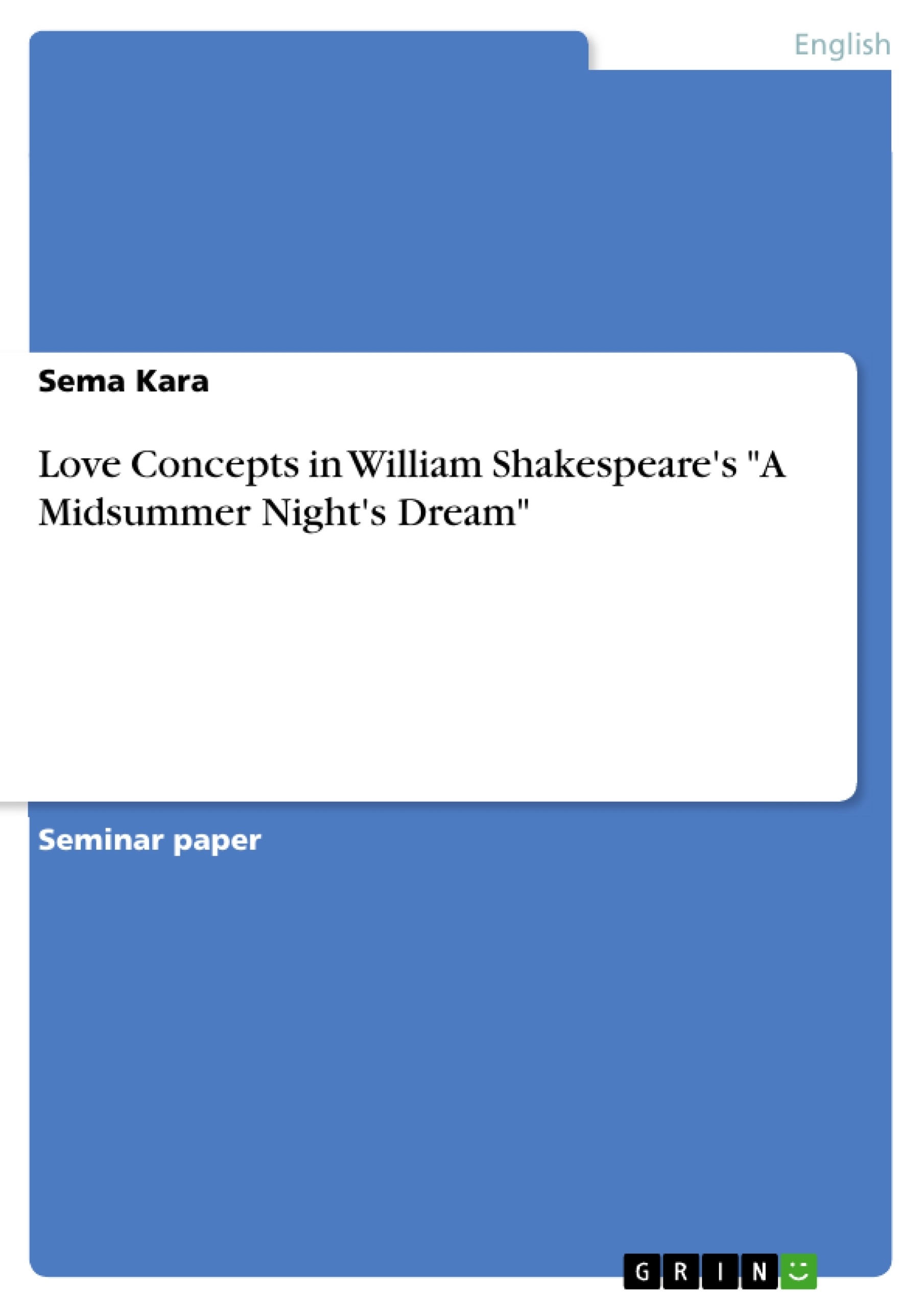“The course of true love never did run smooth” – this statement, made by the male protagonist Lysander in I,1 of A Midsummer Night’s Dream, is arguably one of the most well-known lines from the play. In a nutshell, it represents its: the trials and tribulations of love; the obstacles young love has to overcome, the intrinsic complexities of established love, and the victory of true love in the end.
This paper aims to take a look at the way, how different stages of love and love concepts are represented in AMD. As Shakespeare is said to have written this particular early play between 1594 - 1596 , a closer look will be taken at the conventions of love poetry in the literature of the Elizabethan age. The influence of the Italian Renaissance poet Petrarch’s love poetry concept on Elizabethan love poetry conventions will be of special interest at this point.
Further on, Shakespeare’s very own love concept in his romantic comedies will be compared and contrasted to the love poetry of his age. The late 16th century and early 17th century, from the 1690ies and particularly with the onset of the reign of King James I, brought about a change in the perception and creation of conventional Elizabethan love poetry: from the commonplace Petrarchan conceits to a more individual, realistic yet Puritan depiction of the praised woman . With AMD being conceived in this particular time frame, possible reflections of this literary change of mind in the discussed play will be outlined in the analysis of this play.
Scholars argue, that AMD originally might have been written by Shakespeare for a noble wedding celebration , because of its lenght, the marriages at the end of the play and the different aspects of married life the play offers. The aspect of marriage and marital conventions in the Elizabethan age will be another point of analysis in this paper, determining whether Shakespeare stayed true or subverted common assumptions of married life at his age. The final analysis will try to apply the aforementioned theoretical points to AMD and take a look at how marriage, love, and literary love concepts are represented by the respective couples in the play.
Inhaltsverzeichnis (Table of Contents)
- Introduction
- Love in Elizabethan Literature and Society
- The Petrarchan Love Concept in Elizabethan Poetry
- Marital Conventions in Elizabethan Society
- Shakespeare's Depiction of Marriage and Love in his Romantic Comedies
- Representations of Love and Marriage in A Midsummer Night's Dream
- Conclusion
Zielsetzung und Themenschwerpunkte (Objectives and Key Themes)
This paper analyzes the portrayal of love and marriage in William Shakespeare's "A Midsummer Night's Dream," examining how the play reflects Elizabethan literary and societal conventions. The main focus is on the various stages of love and love concepts presented in the play, particularly within the context of the Elizabethan era.- The influence of Petrarchan love poetry on Elizabethan literary conventions
- The relationship between Shakespeare's depiction of love and marriage in his romantic comedies and the love poetry of his time
- The evolution of Elizabethan love poetry, transitioning from Petrarchan conceits to more individualistic and realistic portrayals
- The role of marriage and marital conventions in Elizabethan society
- The representation of love and marriage in "A Midsummer Night's Dream" through the different couples in the play
Zusammenfassung der Kapitel (Chapter Summaries)
- Introduction: The paper introduces "A Midsummer Night's Dream" and its famous quote about the "course of true love," highlighting the play's focus on the challenges and complexities of love. It sets out the aim of analyzing the different stages and concepts of love depicted in the play, emphasizing the influence of Elizabethan literature and society.
- Love in Elizabethan Literature and Society: This section explores the roots of Elizabethan love poetry, highlighting the significant impact of Petrarchan love poetry and its religious reverence of love and beauty. It examines the conventions of Petrarchan love, including the idealization of the beloved as a pure, innocent, and unattainable figure, and the lover's subjugation and sublimation of their feelings.
- The Petrarchan Love Concept in Elizabethan Poetry: This subsection delves deeper into the Petrarchan concept of love, discussing its origins in medieval love poetry and its influence on Elizabethan love poetry. It explores the emphasis on the spiritual nature of love and beauty, the idealized image of the beloved as a "saint-like woman," and the typical refusal of the lover's advances.
- Marital Conventions in Elizabethan Society: This subsection examines the role of marriage in Elizabethan society, emphasizing the conventions and expectations surrounding married life during that era. It sets the stage for analyzing how Shakespeare might have adhered to or subverted these conventions in his play.
- Shakespeare's Depiction of Marriage and Love in his Romantic Comedies: This section explores Shakespeare's own portrayal of love and marriage in his romantic comedies, comparing and contrasting his approach to the conventions of Elizabethan love poetry. It touches upon the shift towards a more individualistic and realistic depiction of love in the late 16th and early 17th centuries.
- Representations of Love and Marriage in A Midsummer Night's Dream: This section analyzes how love and marriage are represented in "A Midsummer Night's Dream," focusing on the various couples and their relationships. It aims to apply the theoretical points discussed earlier to the specific examples within the play.
Schlüsselwörter (Keywords)
The central themes and topics of this paper include Elizabethan love poetry, Petrarchan conventions, marital conventions, romantic comedies, "A Midsummer Night's Dream," and the representation of love and marriage in Shakespeare's works.- Citation du texte
- Sema Kara (Auteur), 2012, Love Concepts in William Shakespeare's "A Midsummer Night's Dream", Munich, GRIN Verlag, https://www.grin.com/document/209306



